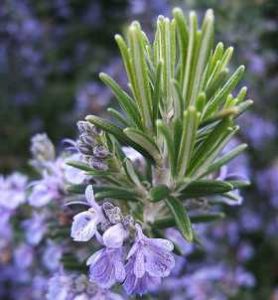How to Grow Rosemary – A  Guide to Growing Rosemary
Guide to Growing Rosemary
This aromatic leaved shrub can be grown in a pot but prefers a sunny spot in a border. Rosemary works particularly well with lamb and a few sprigs thrown onto the barbeque will fill the air with its distinctive scent .
You can buy pot grown rosemary shrubs or as rosemary is easy to cultivate ask a friend for a cutting from their plant .
Varieties of Rosemary
There are many varieties available, some upright and others prostate . The variety of leaf and flower colours available makes rosemary an ornamental shrub as well as a useful culinary herb.
For container or pot growing, try Miss Jessopp’s Upright which has extremely aromatic foliage.
The prostrate varieties of rosemary are lowing growing and trailing such as Majorca Pink, which makes them suitable for growing in a window box or a pot on the patio .
Pests and Problems with Rosemary
Although rosemary is generally trouble free it needs to be kept it in a well-drained situation, particularly during the winter .
Growing Rosemary
Rosemary is best bought as a plant or grown from a cutting rather than grown from seed. Although cultivation is similar to that for a Bay Tree, it will not thrive if it is pot bound.
Rosemary can be transplanted at any time of the year but avoid disturbing the roots.
Rosemary is best planted in a sunny position, in free draining soil. To ensure there is good drainage during the winter you will need to add gravel and sand in the bottom of the pot or planting hole.
If growing in a container either add a slow release fertiliser in the spring , or feed with a general purpose liquid feed monthly during the spring and summer.
Apply a tablespoon of lime to the soil around the plant in winter.
To prevent the plant from becoming too leggy and straggly lightly clip in spring and autumn.
Propagating Rosemary from Cuttings
Cuttings are best taken in May or early June. Snip off an 8 cm (3 inch) piece, from the end of a young shoot then strip the leaves off the lower half. Dip the cutting into hormonal rooting powder and place one cutting (to avoid root disturbance when transplanting) per 8 cm (3 inch) pot of multi-purpose compost. To retain the moisture, place a plastic bag over the top of the pot and secure it with a rubber band. Keep the cutting in a warm place, out of direct sunlight and your cutting should root within six to eight weeks .
Harvesting Rosemary
Rosemary is a hardy evergreen so can be used throughout the year. Cutting as and when you require it for the kitchen will help to prevent your plant from becoming too leggy and straggly .
Eating & Storing Rosemary
Rosemary is an ideal accompaniment for lamb, just push into small slits in the surface of the meat, together with garlic, before cooking.
Placing rosemary on the barbeque coals releases its wonderful scent, or the woody stems can be used as skewers for cubes of meat, sturdy fish and vegetables.
Rosemary is also great with fried potatoes, either cooked in a pan on the hob or in the oven.
Rosemary is an evergreen, hardy perennial so remember you can use it through the winter by adding it to meat stews and sausage dishes.



